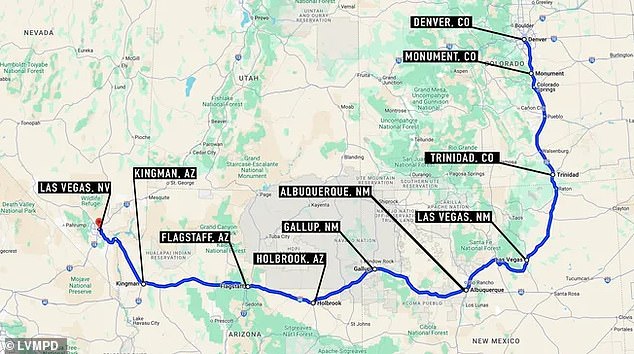Despite a meticulously thought-out suicide plan, the route taken by the Cybertruck attacker from Colorado to Nevada hints at an embarrassing mistake.
Law enforcement officials identified Matthew Livelsberger, 37, as the person who rented a Cybertruck, packed it with explosives and detonated it outside Donald Trump’s Las Vegas resort on January 1.
Now, a map of the route he took from Denver to Las Vegas revealed that not only did he go four hours off the road, but he made a stop in Las Vegas, New Mexico.
The strangely long and winding journey has sparked speculation that he put the wrong destination into the GPS.
The quickest route from Denver to Las Vegas, Nevada, is via I-70 W and I-15 S, which would have taken a total driving time of 11 hours and eight minutes.
Instead, youThe highly decorated Army Special Forces sergeant major traveled I-25 S to I-40 W, which was 15 hours and 28 minutes.
The map, created by Nevada’s Las Vegas Metropolitan Police Department, also shows he stopped to charge the Cybertruck eight times.
According to Tesla, Cybertrucks can travel up to 325 miles on a single charge. But the longest distance Livelsberger traveled between charges was just 148 miles, less than half that maximum distance.
Authorities have mapped the route that ‘Cybertruck bomber’ Matthew Livelsberger took from Denver, CO to Las Vegas, NV in the days before his attack on the Trump Worldwide Resort.
If Livelsberger had taken the faster route, 1-70W to 1-15S, he would have encountered at least 14 Tesla charging stations along the way, suggesting that access to charging stations seems unlikely to be possible. the reason Livelsberger chose the longer route.
Interestingly, 1-25 S is almost a direct road to Las Vegas, New Mexico, one of the places where he stopped to charge.
When comparing the chosen route with the most direct one, it seems that Livelsberger made a mistake in Las Vegas, as many have speculated on social media.
“I wonder if he went to Las Vegas, New Mexico and then realized he was in the wrong place,” one X user posted.
“Imagine his embarrassment when he ended up in the wrong Las Vegas first,” wrote another.
To add another layer of weirdness to Livelsberger’s movements, it appears he stopped to charge more times than necessary during his trip.
The longest distance it traveled between charges was just 148 miles, less than half the distance a Cybertruck can travel on a single charge.
Law enforcement officials have identified Matthew Livelsberger, 37, as the person who rented a Cybertruck, packed it with explosives and detonated it outside the Las Vegas resort on January 1.

Traffic camera photographs were used to reconstruct the Cybertruck’s movements in Las Vegas on January 1.

The Cybertruck arrived at the Trump resort valet area for the second time at 8:39 am. Within 17 seconds, the truck exploded. The driver shot himself moments before
On December 28, Livelsberger rented the Cybertruck in Denver, Colorado, using the peer-to-peer car rental platform Turo.
Heading southeast, the truck made a stop in Monument, Colorado, on December 30, where it was loaded.
That same day, Livelsberger legally purchased two semi-automatic pistols, according to Kenny Cooper, assistant special agent in charge of the ATF field division in San Francisco.
On December 31, the Cybertruck made several charging stops at the following locations: Trinidad, Colorado; Las Vegas, New Mexico; Albuquerque, New Mexico; and Gallup, New Mexico.

The contents of the Tesla Cybertruck after the explosion in front of the Trump Worldwide Resort Las Vegas on January 1, 2025


Among the charred objects found inside the truck were a gun at Livelsberger’s feet, another firearm, several fireworks, a passport, credit cards, an iPhone, a smart watch and his military ID.
On January 1, the day of the explosion, the truck was loaded in Holbrook, Flagstaff and Kingman, Arizona. That final upload was made at 5:33 a.m. about 100 miles from Las Vegas, Nevada.
The truck was first spotted in Las Vegas, Nevada, around 7:30 a.m. on January 1.
At 7:34 a.m., the truck was seen turning onto Trend Present Drive, where the Trump Worldwide Resort is located.
The Cybertruck stopped by the resort’s valet and then spent the next hour, from 7:34 to 8:35 a.m., driving at several different locations along Las Vegas Boulevard.
The truck spent nearly 45 minutes in a commercial parking lot near Las Vegas Boulevard and Flamingo Highway.
At 8:35 a.m., the Cybertruck stopped on Las Vegas Boulevard from Sands Avenue.
The Cybertruck re-entered the Trump resort valet area at 8:39 a.m. Within 17 seconds, the truck exploded.
At some point during those 17 seconds, the driver shot himself in the head, according to Clark County Sheriff Kevin McMahill.

Pictured are items found in the back of the Tesla Cybertruck that exploded outside the Trump Worldwide Resort in Las Vegas.

The driver was killed and burned beyond recognition. But Clark County Sheriff Kevin McMahill. Help investigators obtained photos of the charging station that showed Livelsberger was the driver.
The driver was killed and burned beyond recognition. But McMahill said investigators obtained photos from the charging station that showed Livelsberger “was the individual driving this vehicle” and was alone.
According to the forensic report, the cause of death was suicide by firearm.
The explosion injured seven people, but virtually no damage to the resort. Livelsberger was the only fatality.
Livelsberger likely planned a more damaging attack, but the steel-sided vehicle absorbed much of the force of the crudely constructed explosive, McMahill said.
When inspecting the wreckage, authorities found fireworks mortars and camp fuel canisters stuffed in the back of the Cybertruck, indicating that it was a planned and intentional attack.
At this time, authorities are still working to determine Livelsberger’s motive.





